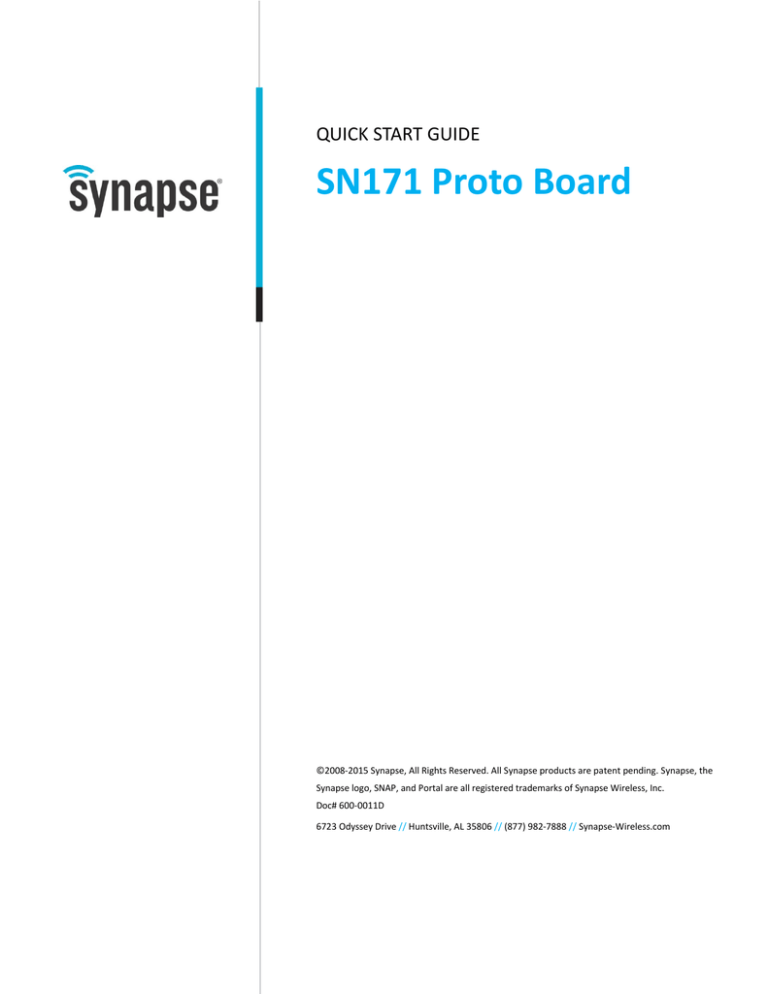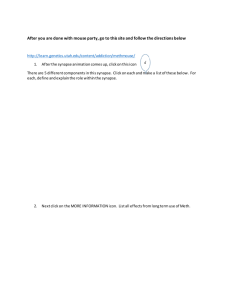
QUICK START GUIDE
SN171 Proto Board
©2008-2015 Synapse, All Rights Reserved. All Synapse products are patent pending. Synapse, the
Synapse logo, SNAP, and Portal are all registered trademarks of Synapse Wireless, Inc.
Doc# 600-0011D
6723 Odyssey Drive // Huntsville, AL 35806 // (877) 982-7888 // Synapse-Wireless.com
Disclaimers
Information contained in this Manual is provided in connection with Synapse products and services and is intended solely to assist its customers. Synapse
reserves the right to make changes at any time and without notice. Synapse assumes no liability whatsoever for the contents of this Manual or the
redistribution as permitted by the foregoing Limited License. The terms and conditions governing the sale or use of Synapse products is expressly
contained in the Synapse’s Terms and Condition for the sale of those respective products.
Synapse retains the right to make changes to any product specification at any time without notice or liability to prior users, contributors, or recipients of
redistributed versions of this Manual. Errata should be checked on any product referenced.
Synapse and the Synapse logo are registered trademarks of Synapse. All other trademarks are the property of their owners. For further information on any
Synapse product or service, contact us at:
Synapse Wireless, Inc.
6723 Odyssey Drive
Huntsville, Alabama 35806
256-852-7888
877-982-7888
256-924-7398 (fax)
www.synapse-wireless.com
License governing any code samples presented in this Manual
Redistribution of code and use in source and binary forms, with or without modification, are permitted provided that it retains the copyright notice,
operates only on SNAP® networks, and the paragraphs below in the documentation and/or other materials are provided with the distribution:
Copyright 2008-2015, Synapse Wireless Inc., All rights Reserved.
Neither the name of Synapse nor the names of contributors may be used to endorse or promote products derived from this software without specific prior
written permission.
This software is provided "AS IS," without a warranty of any kind. ALL EXPRESS OR IMPLIED CONDITIONS, REPRESENTATIONS AND WARRANTIES,
INCLUDING ANY IMPLIED WARRANTY OF MERCHANTABILITY, FITNESS FOR A PARTICULAR PURPOSE OR NON-INFRINGEMENT, ARE HEREBY EXCLUDED.
SYNAPSE AND ITS LICENSORS SHALL NOT BE LIABLE FOR ANY DAMAGES SUFFERED BY LICENSEE AS A RESULT OF USING, MODIFYING OR DISTRIBUTING
THIS SOFTWARE OR ITS DERIVATIVES. IN NO EVENT WILL SYNAPSE OR ITS LICENSORS BE LIABLE FOR ANY LOST REVENUE, PROFIT OR DATA, OR FOR
DIRECT, INDIRECT, SPECIAL, CONSEQUENTIAL, INCIDENTAL OR PUNITIVE DAMAGES, HOWEVER CAUSED AND REGARDLESS OF THE THEORY OF LIABILITY,
ARISING OUT OF THE USE OF OR INABILITY TO USE THIS SOFTWARE, EVEN IF SYNAPSE HAS BEEN ADVISED OF THE POSSIBILITY OF SUCH DAMAGES.
Table of Contents
1.
Introduction ............................................................................................................... 1
2.
Using the SN 171 ........................................................................................................ 2
On-Board Peripherals List ................................................................................................................ 2
Powering Options............................................................................................................................. 3
On-board LEDs ................................................................................................................................. 4
On-board Push-Button ..................................................................................................................... 4
RS-232 Port ...................................................................................................................................... 5
Connectivity Options........................................................................................................................ 5
Mounting Options ............................................................................................................................ 7
1. Introduction
This Quick Start guide attempts to point out the most important features of the Synapse SN171 Proto Board. This
break-out/prototyping board has been created to make it easy to evaluate the Synapse RF Engine (RFE).
The SN171 Proto Board provides easy access to all 19 General Purpose I/O (GPIO) pins of the RF Engine,
including:
•
19 Digital Inputs or Outputs
•
8 Analog Inputs
•
2 UART ports
Note: The analog input and serial port functionality share pins with the digital I/O - you can only have a total of 19
functions at one time. Please refer to the existing RF Engine Datasheet for more details.
On the SN171 Proto Board, none of the I/O pins are dedicated to a single function. At the same time, we wanted
to make it easy to test drive "basic functionality" like blinking a LED, reading a push-button switch, and
communicating over a serial port.
To accomplish this, various jumpers can be installed to connect different RF Engine General Purpose I/O (GPIO)
pins to some on-board peripherals.
Figure 1 - Overhead view of SN171 Proto Board with no RF Engine installed
SN171 Proto Board
1
2. Using the SN 171
On-Board Peripherals List
From a hardware configuration (jumper setting) standpoint, there are five hardware sub-systems to be aware of:
•
Voltage Regulator
•
LED1 – green
•
LED2 – yellow
•
S1 - push-button switch
•
RS-232 port - DB9
Figure 2 - SN171 Proto Board with RF Engine Installed
2
SN171 Proto Board
Powering Options
The SN171 Proto Board can be powered (VCC) through any one of three different connectors:
•
Barrel connector labeled J4 (circled in red)
•
The VEXT pin on terminal block TB2 (circled in yellow)
•
White two-pin header labeled J5 VBAT IN (circled in blue)
Figure 3 - Three places to apply power
The J5 VBAT IN connector accepts 2.7-3.4 volts DC.
The VEXT pin (on terminal block TB2) and connector J4 both accept 5-9 volts DC.
The PWRSEL jumper, located near the center of the board, chooses between the J5 VBAT IN connector, or
either of the J4/VEXT pin connectors. Pin 1 is marked on the silk-screen, plus the individual pins 1, 2, and 3 are
labeled VBAT, VCC, and VEXT.
Jumper
When Installed
PWRSEL
PWRSEL
Connect pins 1-2 (VBAT to VCC)to get VCC from J5 VBAT IN
Connect pins 2-3 (VCC to VEXT)to get VCC from VEXT or J4
Figure 4 - SN171 jumpered for VCC = VEXT
SN171 Proto Board
3
On-board LEDs
Jumper
JMP3
JMP4
When Installed
LED1 (green) can be controlled via GPIO 1
LED2 (yellow) can be controlled via GPIO 2
Simply remove these jumpers to reclaim these pins for other purposes.
Figure 5 - LEDs enabled (both jumpers installed)
On-board Push-Button
Push-button switch S1 is a normally open momentary contact switch that can be connected to processor reset,
pin GPIO 5, or neither.
Figure 6 - S1SEL jumpered for S1 = RESET
Jumper
S1SEL
S1SEL
When Installed
Connecting pins 1-2 connects S1 to GPIO5
Connecting pins 2-3 connects S1 to RESET
You can also leave the jumper off entirely, and switch S1 will do nothing.
4
SN171 Proto Board
RS-232 Port
The RF Engine's UART signals are 3.3 volt logic level, and so must go through a line interface chip before they
can be directly used for RS-485, RS-232, etc.
The SN171 Proto Board includes a RS-232 line driver that can optionally be used with UART 1 (SCI 2). Note that
this is the second serial port of the RF Engine. The first RF Engine serial port is always 3.3 volt logic level.
The RS-232 line driver is enabled and configured through a bank of five jumpers labeled RS232.
Figure 7 - The five RS232 jumpers
Jumper
When Installed
PWR
The RS-232 chip is powered up
RTS
UART 1 RTS is RS-232
CTS
UART 1 CTS is RS-232
TXD
UART 1 TXD is RS-232
RXD
UART 1 RXD is RS-232
Removing one of the RTS, CTS, TXD, or RXD jumpers disconnects the corresponding RS-232 signals from the
DB-9 connector J6. The corresponding 3.3 volt logic level signals remain available at terminal block TB1 and 24pin header J2.
Remove all five jumpers (PWR, RTS, CTS, TXD, and RXD) to disable (power down) the entire RS-232 line driver
chip.
NOTE: Removing the PWR jumper but leaving any of the other four jumpers connected can result in the
unit being unable to start up.
Connectivity Options
Two terminal blocks (one on each side of the board) provide access to all of the GPIO pins, plus various POWER,
GND, and RESET signals.
NOTE: That these terminal blocks DO NOT have the exact same pin-out as the two headers on the RF
Engine!
The RF Engine headers have a total of 24 pins, the two terminal blocks have 28 pins total. The extra pins are
SN171 Proto Board
5
additional GND and POWER connections. Notice the power (VCC) pin between GPIO6 and GPIO7. Also notice
the power (VCC) pin between GPIO14 and GPIO15, and also one next to GPIO18.
Figure 8 - Terminal Blocks on each side of the board
In addition to the two terminal blocks, the RF Engine signals are also available at connector J2 (when loaded).
Note that connector J2 has only 24 pins, and maps to connectors J1A and J1B, not terminal blocks TB1 and TB2.
Connector Table
Connector
Description
J1A
12 pin header, one of two that connect to the Synapse RF Engine
J1B
12 pin header, the second of two that connect to the RF Engine
TB1
14 position terminal block that provides all J1A signals,
plus some additional power and ground pins
14 position terminal block that provides all J1B signals,
plus some additional power and ground signals
A 24 pin connector that provides alternate connection points to the RF
Engine signals
TB2
J2
Note that pins 1-12 of J2 map to connector J1A (not TB1) and pins
13-24 of J2 map to connector J1B (not TB2)
J3
J4
J5
J6
6
This is a standard Background Debug Mode (BDM) interface to the RF
Engine's microprocessor. This connector is usually not installed.
Barrel connector for external DC power (5 - 9 volt range)
Connector for external “Battery" power (2.7 - 3.4 volt range)
This is the DB9 connector for the RS-232 line interface
SN171 Proto Board
Mounting Options
When a Synapse RF engine with SMA connector is used, it is recommended that the mounting holes provided on
the engine (either side of the SMA connector) be used with the included mounting hardware to hard mount the
module to the SN171 proto board. The mounting hardware consists of two plastic standoffs. This allows the unit
to handle the mechanical stresses that can occur when an external antenna is screwed into the SMA. Figure 9
shows the RF Engine with SMA connector mounted to the Proto Board.
Figure 9 – SN171 Board with RF Engine Mounted and Mounting Hardware
When using a Synapse RF engine with integrated F-antenna, in order to maximize RF range in the direction
behind the module, it is recommended that no components and no metal be placed in the area that lies
underneath the engine directly below the internal antenna. It is also recommended that users remove the PCB
mounting tab located directly below the F-antenna.
Figure 10 – SN171 with Mounting Tab Removed
SN171 Proto Board
7

